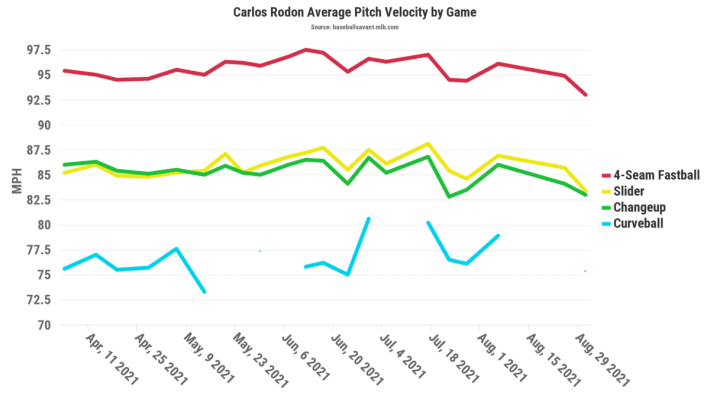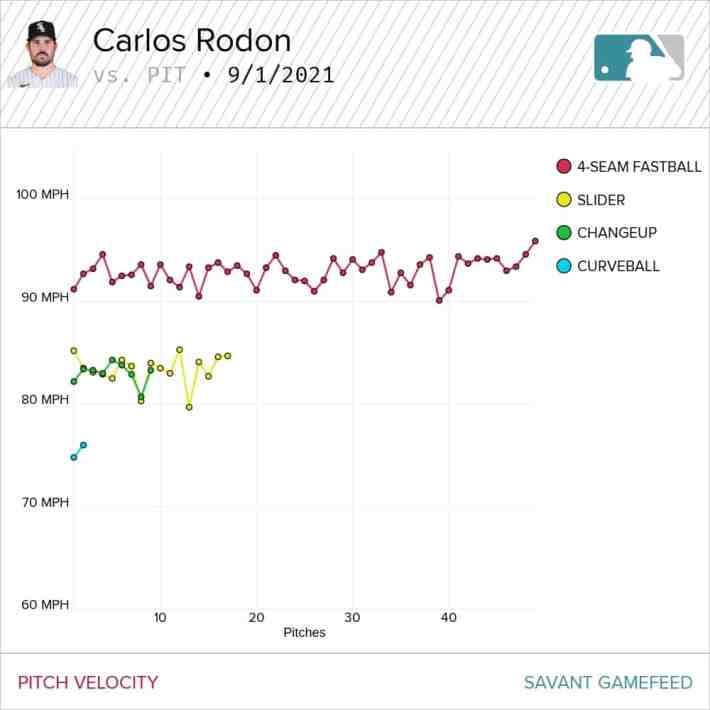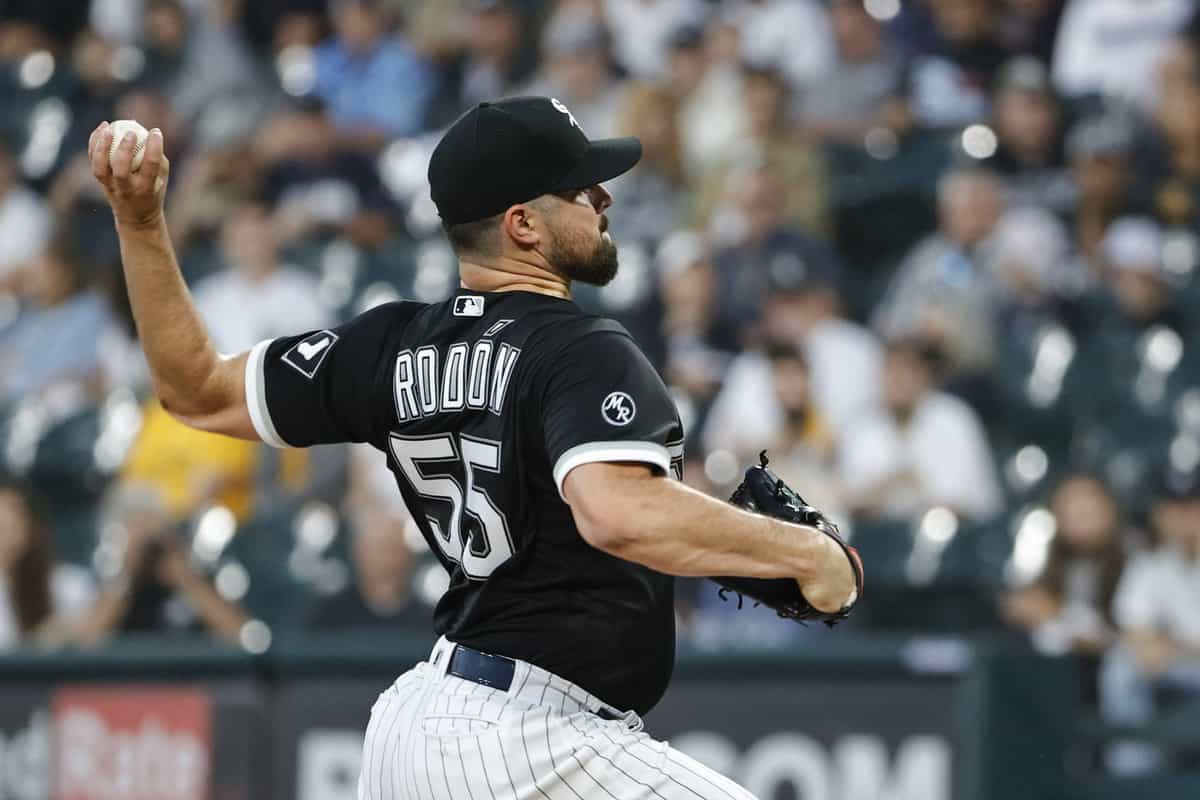The tough thing about watching Carlos Rodón's last two starts is that we learned too much his first 19 of 2021.
We now know that Rodón was capable of striking out 36 percent of hitters he faced while only walking 7 percent of them for a sustained stretch. We know that he can post a sub-3.00 ERA and a sub-3.00 FIP. We know that we can make an All-Star team and deserve every bit of it.
It's hard to set aside the best baseball of his life, but let's briefly pretend that we can focus solely on the version of Rodón that returned from the injured list after a bout of shoulder fatigue. When stacking up his last two starts against the three that came before it over the previous two seasons, they would would register not as a mild letdown, but as a moderate success.
| Date | IP | H | R | ER | BB | K | Avg. | Max |
|---|---|---|---|---|---|---|---|---|
| 9/1/21 | 5 | 5 | 1 | 1 | 1 | 5 | 93 | 95.9 |
| 8/26/21 | 5 | 5 | 2 | 2 | 1 | 3 | 94.9 | 97.3 |
| 7/28/20 | 3.2 | 4 | 5 | 5 | 3 | 4 | 92.8 | 94.4 |
| 5/1/19 | 3.2 | 5 | 3 | 3 | 2 | 6 | 91.5 | 93.7 |
| 4/26/19 | 3 | 9 | 8 | 8 | 3 | 5 | 90.4 | 92.9 |
That was the track record that Rodón took into the fifth starter job this year. While he had a velocity spike in his short appearances at the end of the 2020 season, nobody really knew if it would stick around over a traditional starter's workload.
In this context, Rodón's still beating expectations. He's attacking hitters and winning. Three earned runs over 10 innings is a 2.70 ERA, and with pitch counts of 67 and 77 pitches thrown, there's room to improve in-start stamina.
Alas, it's September, not April, and in the intervening months Rodón escalated his own expectations from "passable fifth starter" to "Cy Young candidate." He did so on the strength of his fastball, and the velocity readings from his last two starts represent a real dip compared to the heat that got him here.

Tony La Russa pulled Rodón after five satisfactory innings against the Pirates on Wednesday despite a pitch count that wouldn't have caused a second thought about a sixth inning. He pointed to what he saw:
“He came out really good for the first three. Fourth, he lost a little bit and in the fifth, he gave us what he had,” White Sox manager Tony La Russa said. “He did a good job of getting us out of the fifth inning but you could tell that stamina was an issue. It wasn't pitch count. It was just watching him and the stuff was -- he gave us what he had. Thinking of sending him out there again wouldn't have been a good move for him or for us."
One might associate "gave us what he had" with flagging velocity, but that wasn't the case. Just like in previous starts, Rodón found his best velocity toward the end of his outing.

Rodón has opened other starts with a low-90s fastball, only to dial it up over the course of his 100 or so pitches based on what situations warranted. The difference on Wednesday is that his best velocity was 95-96 mph, not 99-100 mph.
Those few miles per hour might have to dictate how La Russa manages the end of Rodón's starts. When Rodón can find triple digits in the sixth inning and beyond, he basically becomes his own reliever, and that allows him to neutralize the Times Through the Order Penalty. Hitters showed no ability to figure him out during the first 19 starts:
- First PA: .165/.218/.335
- Second PA: .208/.272/.338
- Beyond: .200/.293/.212
In the limited sample of two starts since the injury, his starts take a more traditional shape.
- First PA: .125/.222/.375
- Second PA: .294/.333/.294
- Beyond: .500/.500/.500
That "beyond" represents a puny sample size of six batters, but it lined up with the eye test on Wednesday. The last three batters he faced all hit the ball harder than 90 mph, including a pair of grounders that tested José Abreu's resilience.
The louder contact later also squares up with his arsenal. He's been mainly fastball-slider this year, which is more than enough when his fastball looks like two different pitches over the course of the game. When he can't find that extra gear, the lack of a trustworthy changeup becomes more apparent, because fewer permutations are available to him.
Rodón trafficked in generalities and clichés with his postgame assessment, leaving you to determine whether he's speaking as a pitcher who's searching for his best stuff, or merely one who's answering questions on autopilot.
“I went out there and pitched five innings and just tried to keep the team ahead and we came up with the win. That was the goal,” Rodón said. “It’s part of the game. It is September. Just go out there and pitch.”
With Lance Lynn on the injured list for knee maintenance and Lucas Giolito on the fence for a hamstring issue, it'd be nice to see first-half Rodón re-enter the frame. There's just a risk in waiting. Rodón's track record over the last three seasons is so limited in size and wide-ranging in scope that the endpoints of the spectrum are "dominant" and "wholly absent." Without a real sound default version of Rodón, we're more or less left to project off the last few starts we've seen, and this one isn't summoning his peak powers. That still leaves a useful pitcher for October. He just might be one who goes four or five innings, rather than six or seven.
Rodón still has several weeks to show more, but there's value in preparing for less. La Russa used his eyes and ears rather than the pitch count and radar gun to inform the length of his leash, and he might want to stick with those senses come October.
(Photo by Kamil Krzaczynski/USA TODAY Sports)





